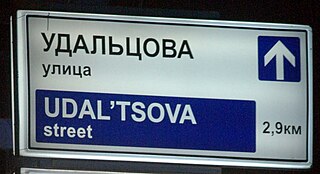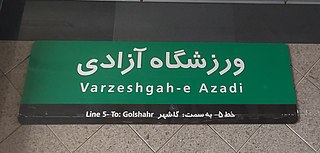Related Research Articles

In linguistics, romanization is the conversion of text from a different writing system to the Roman (Latin) script, or a system for doing so. Methods of romanization include transliteration, for representing written text, and transcription, for representing the spoken word, and combinations of both. Transcription methods can be subdivided into phonemic transcription, which records the phonemes or units of semantic meaning in speech, and more strict phonetic transcription, which records speech sounds with precision.
The Burmese alphabet is an abugida used for writing Burmese. It is ultimately adapted from a Brahmic script, either the Kadamba or Pallava alphabet of South India. The Burmese alphabet is also used for the liturgical languages of Pali and Sanskrit. In recent decades, other, related alphabets, such as Shan and modern Mon, have been restructured according to the standard of the Burmese alphabet

The romanization of the Russian language, aside from its primary use for including Russian names and words in text written in a Latin alphabet, is also essential for computer users to input Russian text who either do not have a keyboard or word processor set up for inputting Cyrillic, or else are not capable of typing rapidly using a native Russian keyboard layout (JCUKEN). In the latter case, they would type using a system of transliteration fitted for their keyboard layout, such as for English QWERTY keyboards, and then use an automated tool to convert the text into Cyrillic.
The romanization of Ukrainian, or Latinization of Ukrainian, is the representation of the Ukrainian language in Latin letters. Ukrainian is natively written in its own Ukrainian alphabet, which is based on the Cyrillic script. Romanization may be employed to represent Ukrainian text or pronunciation for non-Ukrainian readers, on computer systems that cannot reproduce Cyrillic characters, or for typists who are not familiar with the Ukrainian keyboard layout. Methods of romanization include transliteration and transcription.
Romanization of Greek is the transliteration (letter-mapping) or transcription (sound-mapping) of text from the Greek alphabet into the Latin alphabet.

Romanization of Bulgarian is the practice of transliteration of text in Bulgarian from its conventional Cyrillic orthography into the Latin alphabet. Romanization can be used for various purposes, such as rendering of proper names and place names in foreign-language contexts, or for informal writing of Bulgarian in environments where Cyrillic is not easily available. Official use of romanization by Bulgarian authorities is found, for instance, in identity documents and in road signage. Several different standards of transliteration exist, one of which was chosen and made mandatory for common use by the Bulgarian authorities in a law of 2009.
Lao romanization systems are transcriptions of the Lao script into the Latin alphabet.

The romanization of Arabic is the systematic rendering of written and spoken Arabic in the Latin script. Romanized Arabic is used for various purposes, among them transcription of names and titles, cataloging Arabic language works, language education when used instead of or alongside the Arabic script, and representation of the language in scientific publications by linguists. These formal systems, which often make use of diacritics and non-standard Latin characters are used in academic settings for the benefit of non-speakers, contrast with informal means of written communication used by speakers such as the Latin-based Arabic chat alphabet.

The Ukrainian Latin alphabet is the form of the Latin script used for writing, transliteration, and retransliteration of Ukrainian.
The romanization of Khmer is a representation of the Khmer (Cambodian) language using letters of the Latin alphabet. This is most commonly done with Khmer proper nouns, such as names of people and geographical names, as in a gazetteer.
Scientific transliteration, variously called academic, linguistic, international, or scholarly transliteration, is an international system for transliteration of text from the Cyrillic script to the Latin script (romanization). This system is most often seen in linguistics publications on Slavic languages.
Romanization or Latinization of Belarusian is any system for transliterating written Belarusian from Cyrillic to the Latin alphabet.
BGN/PCGN romanization system for Russian is a method for romanization of Cyrillic Russian texts, that is, their transliteration into the Latin alphabet as used in the English language.
The Myanmar Language Commission Transcription System (1980), also known as the MLC Transcription System (MLCTS), is a transliteration system for rendering Burmese in the Latin alphabet. It is loosely based on the common system for romanization of Pali, has some similarities to the ALA-LC romanization and was devised by the Myanmar Language Commission. The system is used in many linguistic publications regarding Burmese and is used in MLC publications as the primary form of romanization of Burmese.
The romanization of Macedonian is the transliteration of text in Macedonian from the Macedonian Cyrillic alphabet into the Latin alphabet. Romanization can be used for various purposes, such as rendering of proper names in foreign contexts, or for informal writing of Macedonian in environments where Cyrillic is not easily available. Official use of romanization by North Macedonia's authorities is found, for instance, on road signage and in passports. Several different codified standards of transliteration currently exist and there is widespread variability in practice.
The BGN/PCGN romanization system for Belarusian is a method for romanization of Cyrillic Belarusian texts, that is, their transliteration into the Latin alphabet.

Romanization or Latinization of Persian is the representation of the Persian language with the Latin script. Several different romanization schemes exist, each with its own set of rules driven by its own set of ideological goals.
There are various systems of romanization of the Armenian alphabet.
BGN/PCGN romanization system for Kazakh is a method for romanization of Cyrillic Kazakh texts, that is, their transliteration into the Latin alphabet as used in the English language.
BGN/PCGN romanization system for Kyrgyz is a method for romanization of Cyrillic Kyrgyz texts, that is, their transliteration into the Latin alphabet as used in the English language.
References
- ↑ J. Okell A Guide to the Romanization of Burmese 2002- Page 7 "3. SURVEY OF THE THREE METHODS OF ROMANIZATION 3.l Transliteration The Burmese use for writing their language a script which is also used for Pali, and as there is a widely accepted romanization system for Pali this can be applied ..."
- ↑ Library of Congress table for romanization of Burmese
- ↑ John P. Ferguson Essays on Burma 1981 Page 77 "4 Romanization of Burmese in this paper follows Mendelson's system in cases of commonly used terms, with a romanization given in parentheses based upon a modification of the Cornyn-Roop system (for details, see Ferguson 1975, ..."
- ↑ Bardwell L. Smith Religion and legitimation of power in Thailand, Laos, and Burma - Page 83 1978 "... by Mendelson (1975). For those trained under the American system, Burmese words will also, on first mention, be romanized on the basis of a literal (as opposed to aural) transcription of written Burmese according to the Cornyn and Roop .."
- ↑ V. I. Braginskiĭ Classical Civilisations of South East Asia: An Anthology University of London. School of Oriental and African Studies - 2002 Page 57 " ... Burmese is romanized in this article according to John Okell's system of ' conventional transcription with accented tones "
- ↑ Minn Latt. The Prague method romanization of Burmese. In Archiv Orientální: journal of the Czechoslovak Oriental Institute, Prague, 26, 1958, pp. 145-167. ProQuest 1304093578